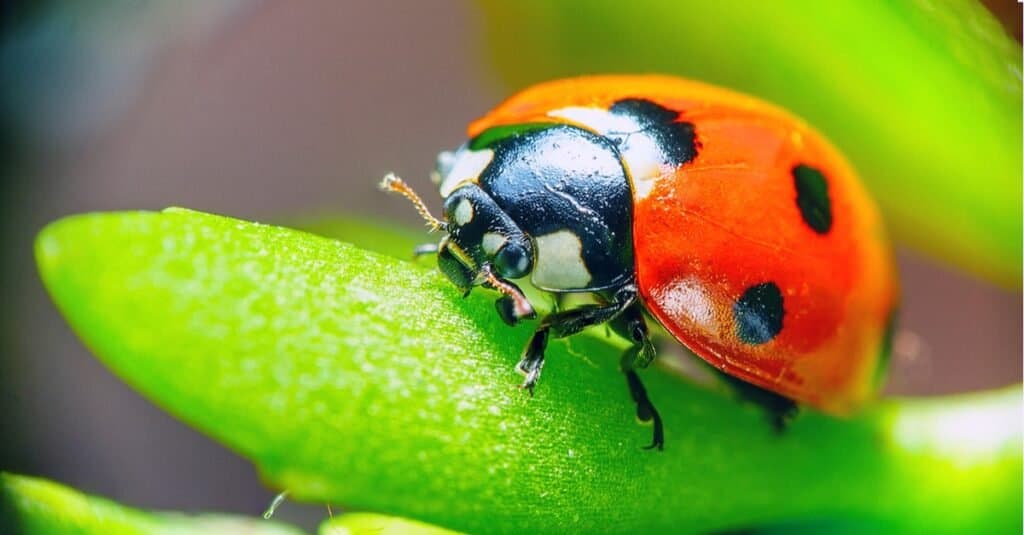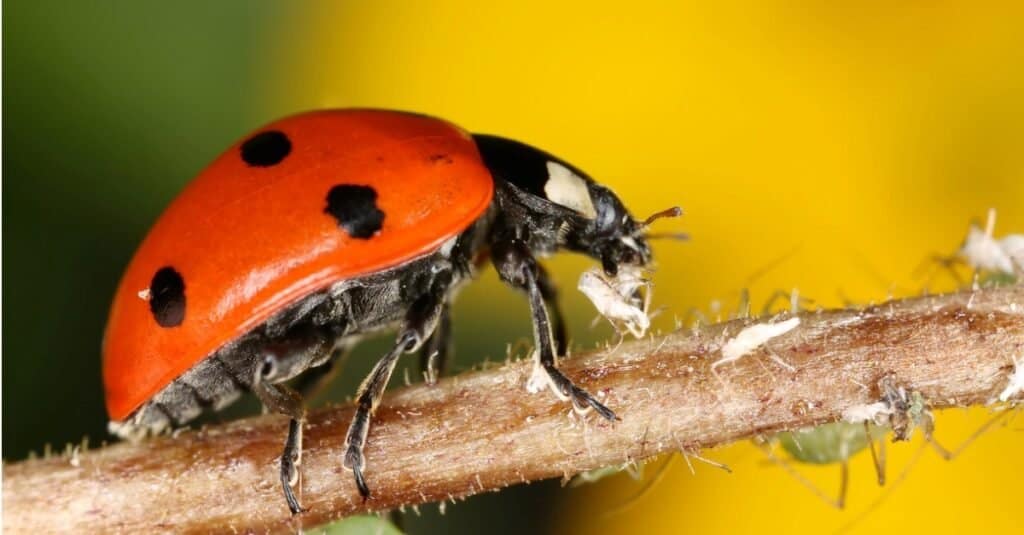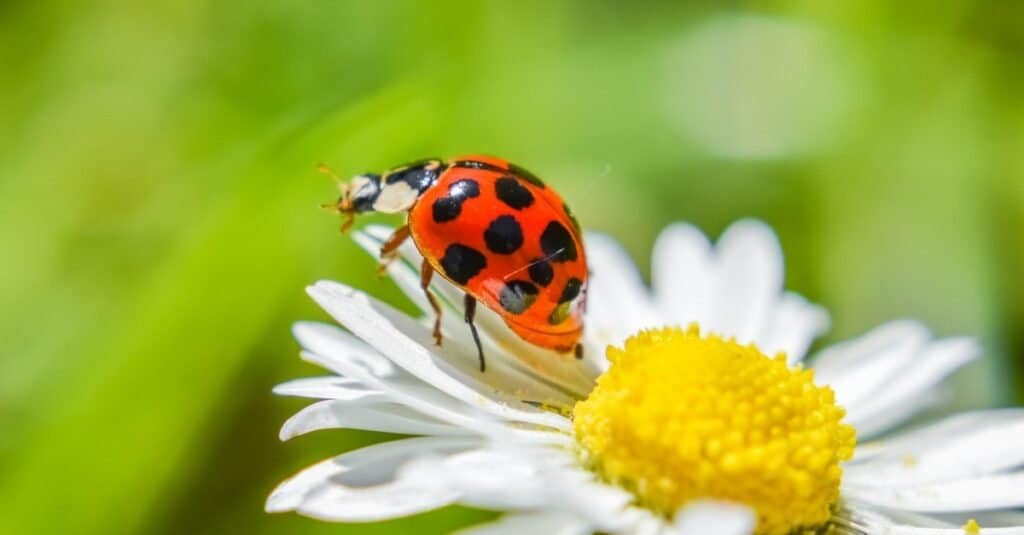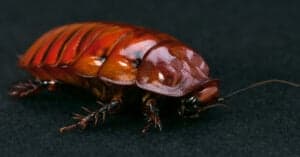Knowing how to tell the difference between an Asian lady beetle vs ladybug can be extremely beneficial, especially if you have a garden in your backyard. While ladybugs are known for being the perfect garden companions, Asian lady beetles are occasionally a different story. These lookalikes often cause more trouble than they’re worth, so it is important to be able to tell these two insects apart. This may be a more difficult task than expected, though!
In this article, we will address some of the key differences between Asian lady beetles and ladybugs so that you can avoid these common pests if you happen to see them in your garden. Let’s get started!
Comparing Asian Lady Beetle vs Ladybug

| Asian Lady Beetle | Ladybug | |
|---|---|---|
| Classification | Harmonia axyridis | Coccinellidae family |
| Size | One of the larger ladybug species | Slightly smaller than lady beetle, but not always |
| Appearance | Extremely variable in its appearance. Often orange or red with black and white spots; can have an M or W pattern on head | Typically bright red with black spots, though also variable; white spots on side of head |
| Behavior | Often found in large clusters; may bite humans; releases foul liquid when threatened | Can have the same behavior as Asian lady beetles, though some species don’t have the same chemical makeup |
| Diet | Ladybugs, native bug populations, aphids, mites, plant matter | Aphids, whiteflies, mites, plant matter |
The Main Differences Between Asian Lady Beetle vs Ladybug

While they are both members of the same bug family (
Coccinellidae), Asian lady beetles are typically slightly larger than ladybugs.
©Mironmax Studio/Shutterstock.com
There are only a few key differences between Asian lady beetles vs ladybugs. All Asian lady beetles are technically ladybugs, but not all ladybugs are Asian lady beetles. While they are both members of the same bug family (Coccinellidae), Asian lady beetles are typically slightly larger than ladybugs. However, this shouldn’t be used as your only means of identification.
When it comes to their appearances, both of these beetles can be found in a variety of colors, shapes, and markings, making it nearly impossible to identify what species you’re dealing with. However, most Asian lady beetles can be identified by an M or W marking on their head, while many ladybugs do not have this marking.
Let’s take a look at these slight differences in more detail now.
Asian Lady Beetle vs Ladybug: Size
One key difference between Asian lady beetles and ladybugs is their size. While it can be difficult to tell unless the two bugs are side by side, Asian lady beetles tend to grow larger than ladybugs. However, both beetles average around a centimeter in length. This means that this metric isn’t ideal for telling them apart in the wild. You may not be satisfied by simply comparing their sizes, and you may still misidentify which beetle you are dealing with!
Asian Lady Beetle vs Ladybug: Appearance and Markings

Most Asian lady beetles can be identified by an M or W marking on their head, while many ladybugs do not have this marking.
©Milton Buzon/Shutterstock.com
The primary difference between an Asian lady beetle and a ladybug can be found in their overall appearance and markings. Remember though that there are so many different types of ladybug species. There are significant overlaps in the appearances of these beetles. No single physical trait will help you identify which one you have in your garden!
It is difficult to tell these two bugs apart, especially because ladybugs typically have white spots along the sides of their heads. Asian lady beetles will often have this as well. However, there is one distinct physical appearance that you can keep an eye out for when trying to tell the difference between two insects.
Asian lady beetles typically have a trademark M or W on their body, often in black or white on their head. While this can be difficult to pick up on at first, you will no doubt notice it when you look at a ladybug and an Asian lady beetle side by side. You may also notice that an Asian lady beetle is longer in body, with a more angular head. By contrast, ladybugs tend to be very round. Remember though that both of these beetles can look identical given that they are members of the same family!

There is very little difference in the behavior of an Asian lady beetle and a ladybug.
©iStock.com/Henrik_L
Asian Lady Beetle vs Ladybug: Typical Behavior
Given that Asian lady beetles and ladybugs are closely related, their behaviors are very similar. Both ladybugs and Asian lady beetles tend to cluster together when the weather is cold. They often seek out sun spots to stay warm, though Asian lady beetles have been observed invading households during fall more often than other species.
All ladybug species, including Asian lady beetles, bite humans from time to time. They are also all capable of emitting a foul-smelling liquid to deter predators or people alike. However, Asian lady beetles have harmonine present in their defensive behaviors and also carry isopropyl methoxy pyrazine at higher concentrations in their bodies compared to other ladybug species.
Asian Lady Beetle vs Ladybug: Diet

Asian lady beetles are considered an invasive species in more locations compared to other ladybug species.
©iStock.com/sebastianosecondi
A final difference between Asian lady beetles vs ladybugs can be found in their diet. Ladybugs are known for being extremely helpful garden bugs, given that they eat aphids, white flies, mites, and many other unfortunate pests. But what do Asian lady beetles eat?
While the diet of an Asian lady beetle is very similar to that of a ladybug, there is one key difference. Asian lady beetles often eat ladybugs and other native species. While they also eat aphids and plant matter, Asian lady beetles tend to decimate local bug populations due to their appetites and clustering habits. This particular ladybug species is also more resistant to diseases compared to other ladybugs, making them prolific and highly invasive depending on their location!
The photo featured at the top of this post is © Milton Buzon/Shutterstock.com
Thank you for reading! Have some feedback for us? Contact the AZ Animals editorial team.






